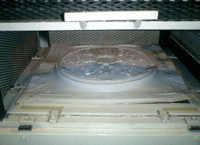| | | 
 The Process The Process
Vacuum forming is the production method of choice for a huge range of products. Beautiful shapes and effects can be created easily on relatively inexpensive tools. Production volumes can also be surprisingly high.
The basic process involves heating a sheet of plastic until it is soft and then sucking it in to shape over a mould. Once the moulding has cooled it can be trimmed to remove any areas of plastic which are not required in the final component.
Advantages of vacuum forming
Relatively cheap tooling
Easy to make large mouldings
Easy to make thin walled mouldings
Choice of beautiful finishes including high gloss, metallics, colours and scratch resistant etc.
Disadvantages
Under cuts are not usually possible.
Internal walls are not possible.
Plastic sheets may need to be scheduled in advance
Comparison with Injection moulding
Unit costs are higher than with injection moulding, but tooling costs are very much lower.
Injection moulding can make much more complicated shapes.
Comparison with GRP
Fibreglass (GRP) is a good material for low volume production, but when demand increases GRP production can lag behind. Not meeting the demand when it is there can quickly result in lost sales.
Typical applications of vacuum forming
Any low or medium volume products which do not justify the huge expense of injection moulding tools.
Large components.
Highly decorative components (often adding value to the product)
Functional components, machine panels, handling and storage trays etc.
Signs.
Point of sale displays. | | | |
| |
|










